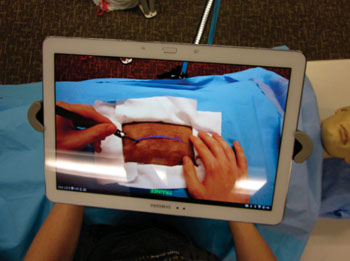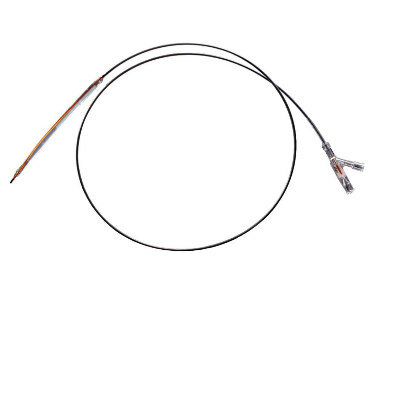Telementoring System Supports Surgeons in the Battlefield
|
By HospiMedica International staff writers Posted on 08 Sep 2015 |

Image: The STAR augmented reality telementoring system (Photo courtesy of Purdue University / ISAT Lab).
A novel augmented reality system could provide effective support to surgeons on the battlefield or other remote locations from specialists located thousands of kilometers away.
Developed by researchers at Purdue University (Lafayette, IN, USA) and Indiana University School of Medicine (Indianapolis, USA), the System for Telementoring with Augmented Reality (STAR) integrates mentor annotations and illustrations directly into the field of view of the surgeon, using a simulated transparent display created by using two networked conventional tablets. Mentor tablet annotations thus remain anchored to the surgical field even when the trainee tablet moves or as the surgical field deforms or becomes occluded.
While existing telestrator-based surgical telementoring systems require a trainee surgeon to shift focus frequently between the operating field and a nearby monitor to acquire and apply instructions from a remote mentor, the STAR superimposes annotations directly onto the surgical field using the transparent tablet. Ongoing research is now focused on improving the robustness of annotation anchoring and the transparent display simulation fidelity. For example, since the surgeon's hands are between the camera and the surgical field, they can momentarily obstruct the mentor's view. An algorithm could render the surgeon's hands semi-transparent.
The researchers are now testing the system while performing procedures commonly carried out in operating rooms, such as cricothyrotomy, in which a tube is inserted into the throat to establish an airway; laparotomy, in which an incision is made in the abdomen to examine internal organs and structures in the abdomen; and fasciotomy, a limb-saving procedure that involves cutting the fascia, a layer of fibrous connective tissue surrounding muscles, to relieve pressure. The study describing the STAR system was published in the October 2015 issue of the Visual Computer.
“Telementoring is widely used, but it's still primitive in that it has not kept pace with advances in information technology and computer graphics,” said senior author associate professor of industrial engineering Juan Pablo Wachs, PhD, of Purdue University. “It is usually done with a telestrator displaying a video of the surgery overlaid with graphical annotations, which requires the surgeon to look away from the operating table while receiving mentoring advice.”
“Optimal surgery and trauma treatment integrates different surgical skills frequently unavailable in rural and field hospitals, and telementoring can provide the missing expertise,” added study coauthor Prof. Gerardo Gomez, MD, director of the division of trauma, surgical critical care, and emergency surgical services at the Indiana University School of Medicine. “Two primary applications are surgeries in the battlefield and in rural regions where specialists might not be available.”
Related Links:
Purdue University
Indiana University School of Medicine
Developed by researchers at Purdue University (Lafayette, IN, USA) and Indiana University School of Medicine (Indianapolis, USA), the System for Telementoring with Augmented Reality (STAR) integrates mentor annotations and illustrations directly into the field of view of the surgeon, using a simulated transparent display created by using two networked conventional tablets. Mentor tablet annotations thus remain anchored to the surgical field even when the trainee tablet moves or as the surgical field deforms or becomes occluded.
While existing telestrator-based surgical telementoring systems require a trainee surgeon to shift focus frequently between the operating field and a nearby monitor to acquire and apply instructions from a remote mentor, the STAR superimposes annotations directly onto the surgical field using the transparent tablet. Ongoing research is now focused on improving the robustness of annotation anchoring and the transparent display simulation fidelity. For example, since the surgeon's hands are between the camera and the surgical field, they can momentarily obstruct the mentor's view. An algorithm could render the surgeon's hands semi-transparent.
The researchers are now testing the system while performing procedures commonly carried out in operating rooms, such as cricothyrotomy, in which a tube is inserted into the throat to establish an airway; laparotomy, in which an incision is made in the abdomen to examine internal organs and structures in the abdomen; and fasciotomy, a limb-saving procedure that involves cutting the fascia, a layer of fibrous connective tissue surrounding muscles, to relieve pressure. The study describing the STAR system was published in the October 2015 issue of the Visual Computer.
“Telementoring is widely used, but it's still primitive in that it has not kept pace with advances in information technology and computer graphics,” said senior author associate professor of industrial engineering Juan Pablo Wachs, PhD, of Purdue University. “It is usually done with a telestrator displaying a video of the surgery overlaid with graphical annotations, which requires the surgeon to look away from the operating table while receiving mentoring advice.”
“Optimal surgery and trauma treatment integrates different surgical skills frequently unavailable in rural and field hospitals, and telementoring can provide the missing expertise,” added study coauthor Prof. Gerardo Gomez, MD, director of the division of trauma, surgical critical care, and emergency surgical services at the Indiana University School of Medicine. “Two primary applications are surgeries in the battlefield and in rural regions where specialists might not be available.”
Related Links:
Purdue University
Indiana University School of Medicine
Channels
Critical Care
view channel
Light-Based Technology to Measure Brain Blood Flow Could Diagnose Stroke and TBI
Monitoring blood flow in the brain is crucial for diagnosing and treating neurological conditions such as stroke, traumatic brain injury (TBI), and vascular dementia. However, current imaging methods like... Read more
AI Heart Attack Risk Assessment Tool Outperforms Existing Methods
For decades, doctors have relied on standardized scoring systems to assess patients with the most common type of heart attack—non-ST-elevation acute coronary syndrome (NSTE-ACS). The GRACE score, used... Read moreSurgical Techniques
view channel
Minimally Invasive Endoscopic Surgery Improves Severe Stroke Outcomes
Intracerebral hemorrhage, a type of stroke caused by bleeding deep within the brain, remains one of the most challenging neurological emergencies to treat. Accounting for about 15% of all strokes, it carries... Read more
Novel Glue Prevents Complications After Breast Cancer Surgery
Seroma and prolonged lymphorrhea are among the most common complications following axillary lymphadenectomy in breast cancer patients. These postoperative issues can delay recovery and postpone the start... Read morePatient Care
view channel
Revolutionary Automatic IV-Line Flushing Device to Enhance Infusion Care
More than 80% of in-hospital patients receive intravenous (IV) therapy. Every dose of IV medicine delivered in a small volume (<250 mL) infusion bag should be followed by subsequent flushing to ensure... Read more
VR Training Tool Combats Contamination of Portable Medical Equipment
Healthcare-associated infections (HAIs) impact one in every 31 patients, cause nearly 100,000 deaths each year, and cost USD 28.4 billion in direct medical expenses. Notably, up to 75% of these infections... Read more
Portable Biosensor Platform to Reduce Hospital-Acquired Infections
Approximately 4 million patients in the European Union acquire healthcare-associated infections (HAIs) or nosocomial infections each year, with around 37,000 deaths directly resulting from these infections,... Read moreFirst-Of-Its-Kind Portable Germicidal Light Technology Disinfects High-Touch Clinical Surfaces in Seconds
Reducing healthcare-acquired infections (HAIs) remains a pressing issue within global healthcare systems. In the United States alone, 1.7 million patients contract HAIs annually, leading to approximately... Read moreBusiness
view channel
Philips and Masimo Partner to Advance Patient Monitoring Measurement Technologies
Royal Philips (Amsterdam, Netherlands) and Masimo (Irvine, California, USA) have renewed their multi-year strategic collaboration, combining Philips’ expertise in patient monitoring with Masimo’s noninvasive... Read more
B. Braun Acquires Digital Microsurgery Company True Digital Surgery
The high-end microsurgery market in neurosurgery, spine, and ENT is undergoing a significant transformation. Traditional analog microscopes are giving way to digital exoscopes, which provide improved visualization,... Read more
CMEF 2025 to Promote Holistic and High-Quality Development of Medical and Health Industry
The 92nd China International Medical Equipment Fair (CMEF 2025) Autumn Exhibition is scheduled to be held from September 26 to 29 at the China Import and Export Fair Complex (Canton Fair Complex) in Guangzhou.... Read more














